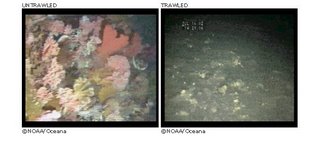Satellite Images Reveal State of Health of World's Coral Reefs

Image: Hawaii's Pearl and Hermes Atoll, shown here in a 20-mile-by-20-mile Landsat 7 image, is part of the recently designated Northwestern Hawaiian Islands Marine National Monument, the largest protected marine area in the world. (Credit: NASA)
A first-of-its-kind survey of how well the world's coral reefs are being protected was made possible by a unique collection of NASA views from space.
A team of international researchers using NASA satellite images compiled an updated inventory of all "marine protected areas" containing coral reefs and compared it with the most detailed and comprehensive satellite inventory of coral reefs. The global satellite mapping effort is called the Millennium Coral Reef Mapping Project and was funded by NASA. The study was reported on recently in the journal Science.
The assessment found that less than two percent of coral reefs are within areas designated to limit human activities that can harm the reefs and the sea life living in and around them. Countries around the world have created these protected ocean and coastal zones where human activities such as shipping, fishing, recreation and scientific research are restricted to varying degrees.
"The contribution of NASA images to this project was crucial," says study lead author Camilo Mora, a marine biologist at Dalhousie University, Canada. "The satellite images allowed us to pinpoint where coral reefs are actually located within coastal marine ecosystems."
The Millennium Project collection of global satellite images of coral reefs was first released in 2003; maps derived from these images were released in 2004. The images are now publicly available from NASA's Goddard Space Flight Center, Greenbelt, Md. Landsat 7 was designed by NASA and launched in 1999. The Landsat Program is a series of Earth-observing satellite missions jointly managed by NASA and the Department of the Interior's U.S. Geological Survey.
To achieve detailed, worldwide views of the very small and widely scattered reefs, the Millennium Project team analyzed nearly 1700 images taken by the Landsat 7 spacecraft over four years. Computer processing of these data resulted in the coral reef inventory and maps that revealed detailed information about the structure of individual reefs.
The new study found that while the number of marine protected areas has been increasing, the level of effective worldwide protection of coral reefs is small. The study also found that most protected zones are too small to provide protection for fish species that routinely swim outside the boundaries. Only a handful are big enough to protect fish and marine life that naturally range outside their boundaries.
"This research points out how much still needs to be done to protect coral reef ecosystems," said Frank Muller-Karger, one of the developers of the Millennium Project at the University of South Florida's Institute for Marine Remote Sensing in St. Petersburg. "Creating large reserves such as the new Northwestern Hawaiian Islands Marine National Monument is just such a step in the right direction." On June 15, the United States created the largest protected marine area in the world, which includes 4,500 square miles of relatively undisturbed coral reef habitat.
"Natural resource managers around the world and conservation groups actively use these coral reef satellite views to advance a wide range of habitat protection projects," says Serge Andréfouët, who developed the methods to create the Millennium coral reef maps. Andréfouët, co-author of the Science article, studies reefs with remote-sensing technology at the French Institut de Recherche pour le Développement in New Caledonia.
Source: NASA/Goddard Space Flight Center



